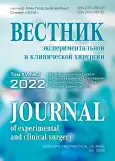Influence of the Distraction Cavity Size on the Choice of the Compression Technique in Thoracoplasty in Patients with Advanced Fibrous-Cavernous Tuberculosis
- Authors: Belov S.A.1
-
Affiliations:
- Department of the seaside regional antituberculous dispensary
- Issue: Vol 15, No 2 (2022)
- Pages: 136-140
- Section: Original articles
- URL: https://journal-vniispk.ru/2070-478X/article/view/149043
- DOI: https://doi.org/10.18499/2070-478X-2022-15-2-136-140
- ID: 149043
Cite item
Full Text
Abstract
Introduction. Extrapleural upper-posterior thoracoplasty is the most common non-resectable surgery in the treatment of patients with advanced fibrous-cavernous pulmonary tuberculosis. However, there is still no unified approach in choosing the thoracoplasty and compression options of the destruction cavity.
The aim of the study was to assess clinical outcomes of various compression methods in extrapleural upper-posterior thoracoplasty considering the destruction cavity size.
Materials and methods. The study included 233 cases of upper posterior thoracoplasty performed in 2012-2019. All cases were fibrous-cavernous pulmonary tuberculosis when the process extended beyond one lobe and was widespread. Group 1 (n=70) involved patients with hybrid thoracoplasty with polypropylene mesh; group 2 (n=60) involved patients with modified osteoplastic thoracoplasty; group 3 (n=103) involved patients with conventional selective extrapleural upper-posterior thoracoplasty. When analysed, attention was paid to elimination of the decay cavity and bacterial excretion.
Results. The publications analysed demonstrate that the main criteria for choosing a plastic surgery option are traditions of the clinic and personal preferences of a surgeon. The study evidenced the best performance of hybrid compression over conventional and modified thoracoplasty (p<0,05). Obviously, the choice of thoracoplasty option and the number of resected ribs should be based on the data including the total size of the destruction cavity and the compression technique.
Conclusion. The proposed distribution of upper-posterior thoracoplasty depending on the compression technique allows individually selecting the most effective treatment options for patients with widespread fibrous-cavernous tuberculosis with destruction cavities up to 6 cm localized in the upper lung.
Keywords
Full Text
##article.viewOnOriginalSite##About the authors
Sergei Anatolievich Belov
Department of the seaside regional antituberculous dispensary
Author for correspondence.
Email: sur_belove@mail.ru
ORCID iD: 0000-0001-5325-2891
SPIN-code: 6588-1047
ResearcherId: C-7576-2019
Candidate of medical science, thoracic surgeon of the 4th pulmonary surgical
Russian Federation, 690041, Russia, Vladivostok, 2 Fifteenth streetReferences
- Vаsilyevа IА, Belilovsky EM, Borisov SE, Sterlikov SА. Multi drug resistant tuberculosos in the countries of the outer world and in the russianfederation. Tuberkulez i bolezni legkikh. 2017; 95(11): 5-17. (in Russ.) doi: 10.21292/2075-1230-2017-95-11-5-17
- Raviglione MC, Korobitsyn AA. End tb – the new who strategy in the sdg era, and the contributions from the russian federation. Tuberkulez i bolezni legkikh. 2016; 94(11): 7-15. (in Russ.) doi: 10.21292/2075-1230-2016-94-11-7-15
- Tsybikova EB, Punga VV, Rusakova LI. Tuberculosis with concurrent hiv infection in russia: statistics and correlations. Tuberkulez i bolezni legkikh. 2018; 96(12): 9-17. (in Russ.) doi: 10.21292/2075-1230-2018-96-12-9-17
- Medovarov EV, Pavlunint AV, Panchenkot NI, Melnikov NV, Azina GM. Collapse thoracoplasty and bronchial valve blockage in patients with fibro-cavernous pulmonary tuberculosis: short- and long-term results. Universitetskaya Klinika. 2017; 25(4-1): 119-126. (in Russ.)
- Sinicyn MV, Agkacev TV, Reshetnikov MN, Pozdnyakova EI, Iczkov AV, Gazdanov TA, Plotkin DV. Extrapleural pneumolysis with filling in treatment of patients with destructive pulmonary tuberculosis. Khirurgiya. 2018; 1-2: 54-63. (in Russ.)
- Trusov VN, Nekrasov EV, Fajzullin DR, Semenov GI. Osteoplastic torakomyoplasty, preserving the skeleton of the chest wall, as an option of surgical treatment of patients with empyema of the residual pleural cavity after pneumonectomy. Tuberkulez i sotsial'no-znachimye zabolevaniya. 2016; 5: 13-17. (in Russ.)
- Bagirov MA, Krasnikova EV, Aliev VK, Ibriev AS. Possibilities of using extrapleural packing with silicon at the surgical stage of treatment of disseminated pulmonary tuberculosis. Tuberkulez i bolezni legkikh. 2015; 6: 19-19. (in Russ.)
- Shapovalov AS, Polezhaev AA, Belov SA. Collapse therapy in pulmonary tuberculosis: a return to basics. Tikhookeanskii meditsinskii zhurnal. 2017; 1: 84-87. (in Russ.) doi: 10.17238/PmJ1609-1175.2017.1.84-87
- Motus IYa, Golubev DN, Bazhenov AV, Neretin AV. Pulmonary tuberculosis surgery. Tuberkulez i bolezni legkikh. 2012; 89(6): 14-20. (in Russ.)
- Kuhtin O, Veith M, Alghanem M, Martel I, Giller D, Haas V, Lampl L. Thoracoplasty-current view on indication and technique. Thorac Cardiovasc Surg. 2020;68(4):331-340. doi: 10.1055/s-0038-1642633
- Krasnov DV, Skvortsov DA, Krasnov VA, Grishhenko NG, Sklyuev SV, Lukyanova MV. Surgery treatment of disseminated fibrous cavernous pulmonary tuberculosis with use of osteoplastic thoracoplasty through minimum access. Tuberkulez i bolezni legkikh. 2015; 6: 82-83. (in Russ.)
- Belov SA, Grigoryuk AA. Use of polypropylene mesh in superior posterior thoracoplasty. Vestnik khirurgii imeni I.I. Grekova. 2019; 178(1): 45-48. (in Russ.) doi: 10.24884/0042-4625-2019-178-1-45-48
Supplementary files









